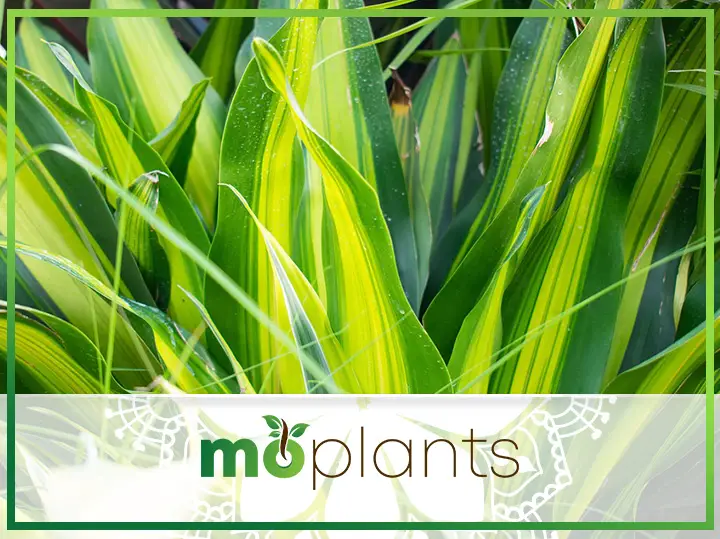Bring the great outdoors indoors by sprucing up your home with the stately corn plant (dracaena). The upright stature of this tropical beauty paired with luscious foliage has made it a favorite among homeowners and interior designers alike. You are likely to find this dazzling houseplant adorning the corners of high-end houses, hotels, and offices. They can add a natural element to any space without overpowering the overall décor.
The corn plant gets its interesting name from its long and narrow leaves that resemble the stalks of the maize plant or the regular corn. It is an incredibly robust and resilient houseplant that is highly forgiving of neglect. It will thrive in pretty much any part of your house and continue to flourish even if you occasionally forget to water it.
So, if you are a gardening novice or someone who has to travel frequently and can’t keep plants alive for long, this striking houseplant will be a perfect companion for you.
Here is everything you should know about growing the delightful corn plant indoors.
Introduction: Corn Plant (Dracaena)
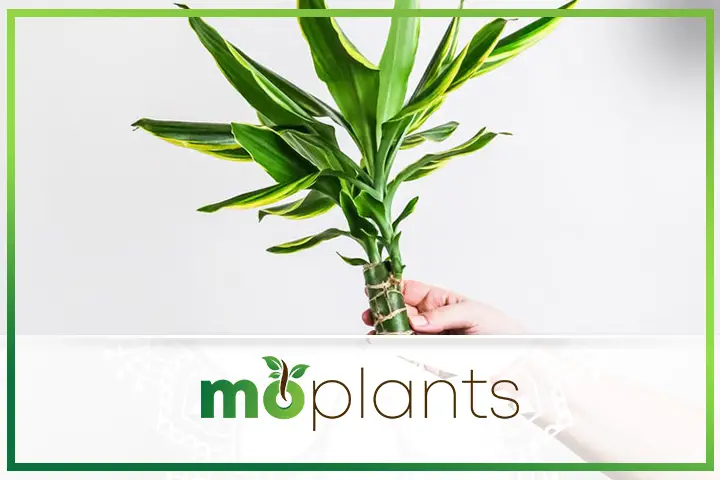
The botanical name of the corn plant is Dracaena fragrans, and it belongs to the Asparagaceae or Asparagus family. Its resemblance to the stalks of corn and palm trees has also earned it the nicknames of mass cane and false palm.
Though native to tropical Africa, this evergreen tree has been a popular houseplant in Europe since the mid-19th century and in the United States since the early 1900s. Corn plants grow incredibly well in USDA Hardiness Zones 10 to 12, which means they prefer a warm and humid environment. Nonetheless, you can also overwinter these hardy houseplants and ensure they continue to brighten your home for many years.
Dracaena plants feature a thick cane of stem that produces unbranched green leaves growing in an upwards direction. In its native habitat, the corn plant can grow between 15 to 50 feet tall and three to ten feet wide. However, when grown indoors in a container, this houseplant usually tops out at six feet.
The sword-shaped arching leaves of corn plants can grow up to two feet long and four-inch wide, with some varieties boasting a broad yellow or cream-colored stripe in the middle. The lifespan of these leaves is two to three years on average, after which they begin to turn yellow and eventually fall off the plant.
The mature corn plants can bloom up to three times a year, though younger plants are not likely to bloom in an average home environment. The stalk grows from the center of the leaf whorl and produces white and yellow flowers resembling a spike ball. These blossoms are highly fragrant, though you can only smell them at night when they bloom.
One of the best things about growing a corn plant indoors is that it adds a subtle attitude to your interior design without requiring much care and attention. It is fairly low maintenance and grows at a rather slow pace, so you won’t have to worry about pruning it too often.
Moreover, this plant is known for its air-purifying qualities. Placing a dracaena plant in your bedroom or living room will remove toxins such as xylene, benzene, formaldehyde, and trichloroethylene from the environment. Hence, it is an ideal option for those suffering from dust and other allergies.
The only downside to this plant is that it can be toxic to cats and dogs. So, if you have any curious pets in your household, please make sure to keep them away from these tropical houseplants.
How to Grow Corn Plant (Dracaena)
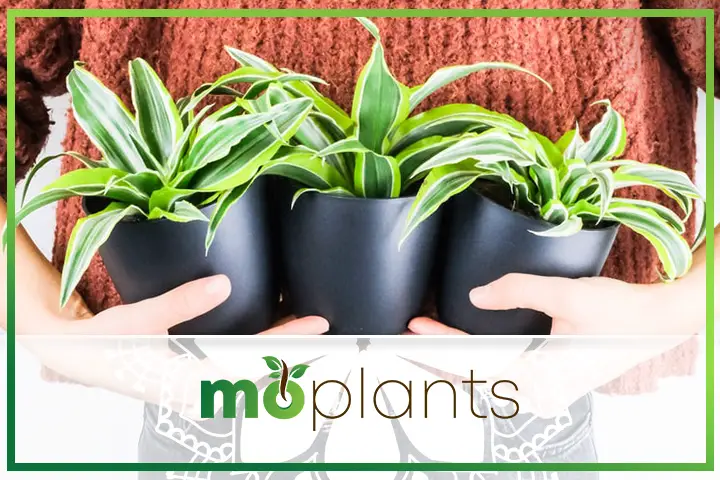
If you are a beginner with a brown thumb, the thought of growing a corn plant indoors may be stressing you out. However, you will be glad to know that growing this iconic houseplant is easier than many people realize.
Here are some tips on how to grow corn plants in your home.
Planting and Placement
The spring and summer months are ideal for transplanting and propagating corn plants. Nonetheless, if you can provide your houseplants with a climate-controlled environment, you can potentially start them at any time of the year without breaking a sweat.
In addition, it is best to place your corn plant near a window or at a spot that receives plenty of filtered light throughout the day. If you plan to display this ornamental beauty on your patio or deck, please make sure to choose a partially shaded spot to protect the foliage from sunburn.
Exposure to Sunlight
As mentioned above, corn plants prefer partial shade or indirect sunlight. Although they can tolerate full sun and low light conditions, it would be best to keep them in the proximity of a window or a door, so they can grow comfortably.
It is also worth mentioning that placing corn plants in a dark corner of your home is likely to stunt their growth and cause the leaves to lose their color.
Watering Frequency
If you are planning to grow corn plants indoor, it is recommended to keep the soil slightly moist at all times. You can water your houseplant once every one to two weeks during the growing season and reduce the frequency once the temperature begins to drop.
The best way to determine if your plant needs more moisture is to touch its soil. If the potting medium feels wet and soggy, move your dracaena fragrans to a sunny spot so they can dry quickly. On the other hand, if the soil feels too dry, please water the plant immediately.
Potting Mix
Well-drained soil with a pH level between 6.1 and 6.5 is ideal for growing these exotic plants.
This tropical beauty prefers a loose and loamy potting mix. You can either buy specialized soil from your local garden center or create your own potting medium by mixing regular potting soil, peat moss, and perlite.
Infographic
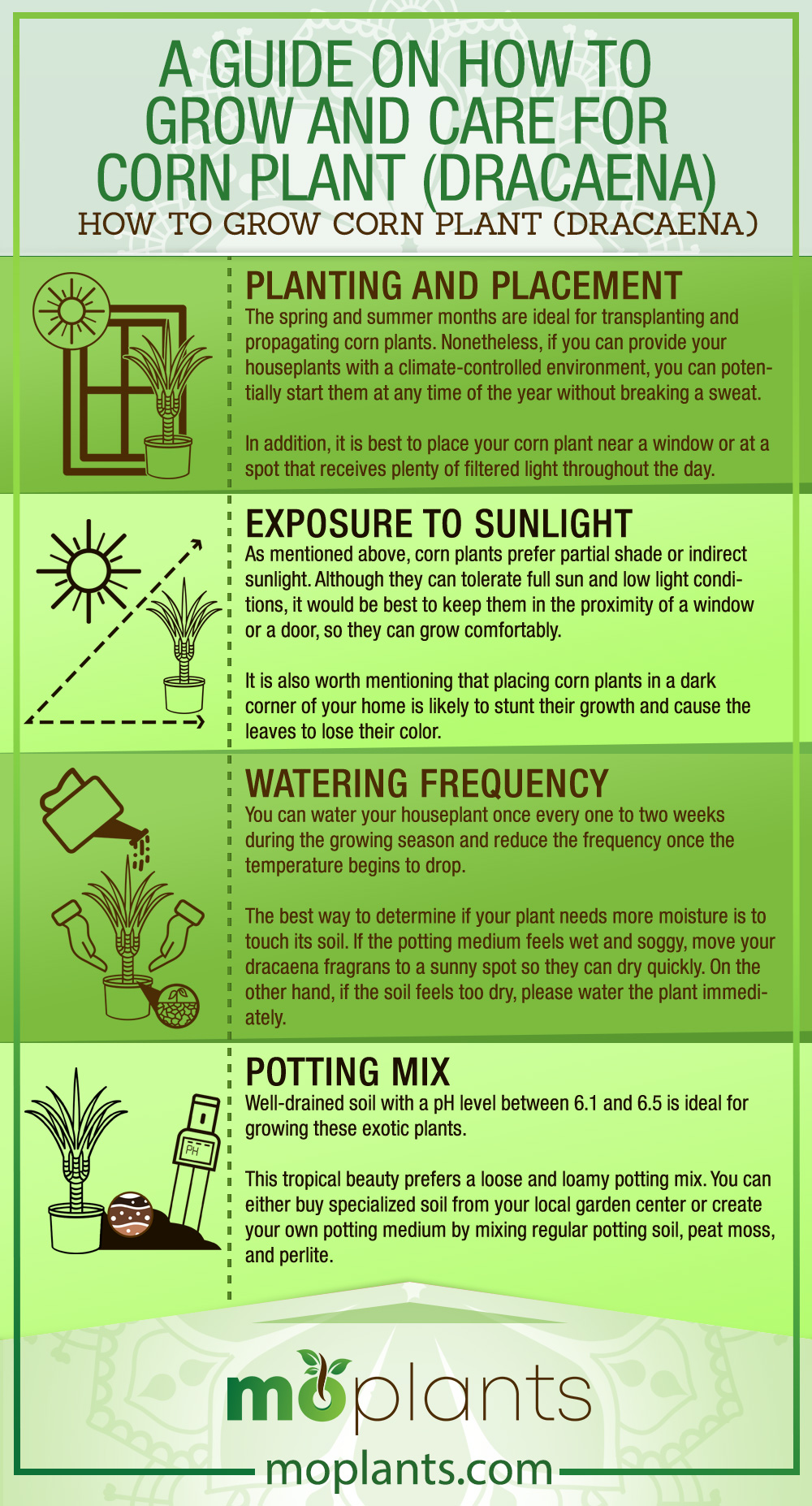
Corn Plant Propagation Method
The most effective way to propagate corn plants is through cuttings.
Please select at least a healthy eight-inch stem from the cane of your plant and cut it using a pair of sharp, sterilized pruning shears. Make sure to cut the stem at an angle so it can regrow in a few months. This way, you won’t have to worry about ruining the aesthetics of your beloved plant.
Next, remove all but four leaves from the cutting and dip its cut end in a rooting powder. As the stem dries, take a small container and fill it with coarse sand before inserting the cutting in the middle. Move the new plant to a well-lit location away from the full sun keep the soil slightly moist. Please note that adding too much water at this point may result in fungus and rot.
It typically takes about eight weeks for corn plant cuttings to develop roots. Once you notice the tiny roots taking hold in the pot, please gently transplant the young dracaena plant to a new container filled with suitable potting mix. You can move the plant to an ideal location in your home and water it regularly.
Corn Plant Care Tips
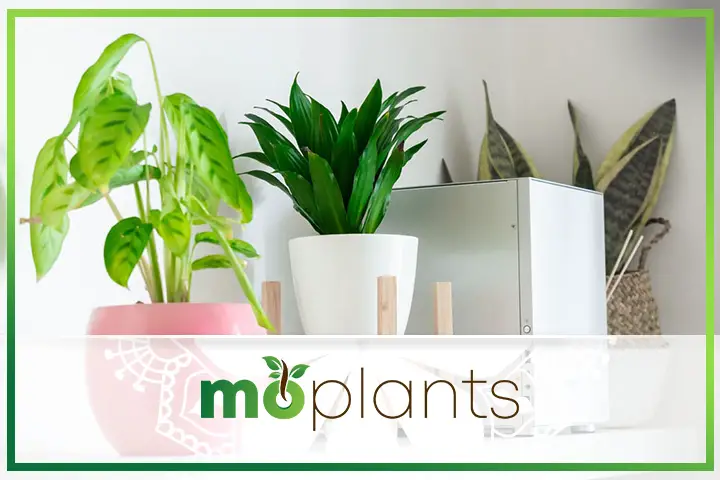
Corn plants may not be high maintenance, but they do need a little love so they can effectively brighten up your space. Let’s look at some of the most important corn plant care tips that will help keep them fresh and healthy for a very long time.
Temperature
Most varieties of corn plants perform well in warm temperatures ranging from 60 to 75 degrees Fahrenheit. It would also be best to protect them from frost and cold drafts. In case you moved your houseplants outdoors during the summer, don’t forget to bring them indoors before the temperature drops to 50 degrees Fahrenheit.
Humidity
As a tropical plant, dracaena fragrans love a humid environment. If you can maintain your indoor humidity levels between 40% and 50%, your houseplant will flourish and become the focal point of any room. However, if you live in a drier climate, investing in a humidifier may be a good idea.
Alternatively, you place your corn plant on top of a tray filled with pebbles and water. As the moisture from the tray evaporates in the air, it will hydrate the foliage without making the soil wet and soggy.
Pruning
Corn plants grow at a relatively slow pace, so you won’t have to prune them frequently. Nevertheless, if you think the plant is becoming too tall for your room, consider cutting the tops of the canes with a pair of clean shears. You should also remove the yellowing leaves once they complete their lifespan.
Fertilizing
These plants are heavy feeders and prefer soil that is rich in nitrogen. You can treat them with a balanced liquid fertilizer every four weeks during the growing season and sparingly in the winter months.
Repotting
You can report your corn plant every two years by moving it to a container at least two to three inches larger and deeper than the existing one. All you need to do is remove the loose soil around the plant base and lift it gently to ensure the roots remain intact. Put some fresh potting medium at the bottom of the new container before placing the plant in its center. Don’t forget to fill the space around the root ball with more soil without packing it too tightly.
Corn plants do well in terracotta pots with a drainage hole at the bottom.
Infographic
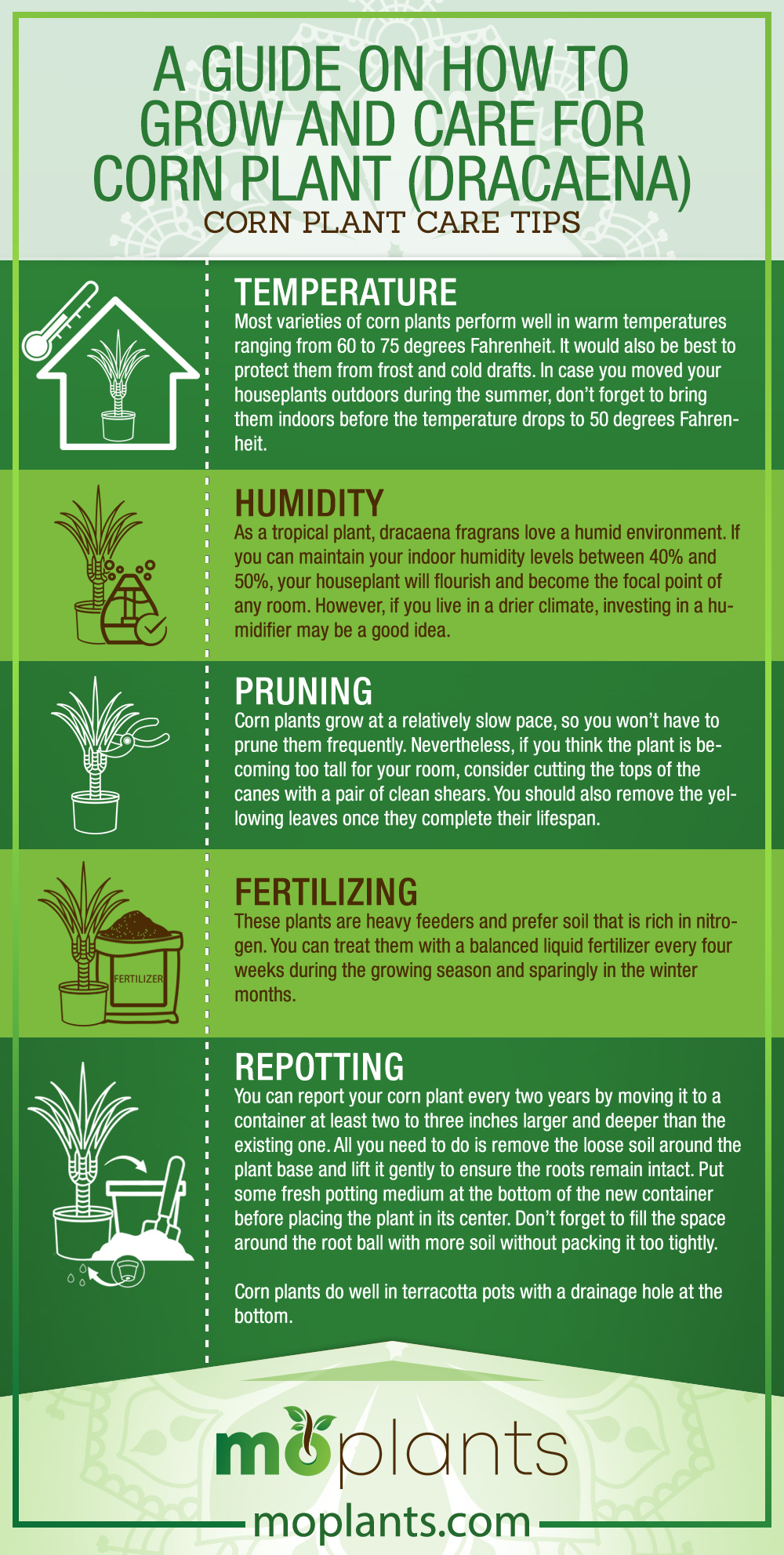
Common Corn Plant Problems and How to Solve Them
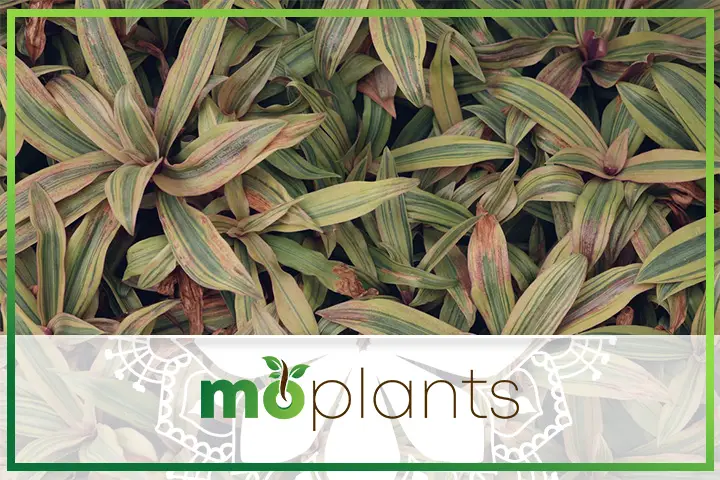
We have rounded up some of the most common issues you may run into while growing corn plants indoors. To help you out, we have also presented practical solutions to keep your houseplant healthy.
Dry Tips and Edges
If the foliage of your corn plant has developed dry tips and edges, it may be a sign that it needs more water. Lack of moisture in the soil and air can cause the leaves to become dry. To troubleshoot this problem, you can water the plant thoroughly and discard the excess fluid that may accumulate in the saucer placed underneath the pot.
Sudden Loss of Leaves
Overwatering is the biggest culprit behind the sudden loss of leaves in corn plants. This condition is a typical sign of root rot, which is mostly caused by poor drainage. You can consider moving your plant to a warmer and sunnier spot in your home until the soil dries out and foliage stops shedding. If the situation persists, you may have to pull out the root ball and trim away the rotten parts before repotting the plant.
Fungal Infections
Tan or reddish spots on the leaves of your dracaena plant may signify a fungal infection known as the fusarium leaf spot. If caught early, you can treat this disease by applying a fungicide to the affected areas.
Overhead watering is usually the biggest reason corn plants develop such infections. Therefore, you may want to refrain from washing the leaves too often.
Soft Rot
If your corn plant is giving off a rotten smell, you may be dealing with soft rot. The most notable sign of this condition is leaf collapse, which usually happens near the base of the plant. Since there is no known cure for this disease, it is recommended to separate the plant from others and dispose of it as soon as possible.
Common Pests and Diseases
Dracaena fragrans can be vulnerable to thrips, scales, and spider mites. Dusting the leaves regularly and watering the plant adequately is usually sufficient to keep these pests away. Nevertheless, if you have noticed these bugs moving around on the foliage, consider washing it with insecticidal soap and applying horticulture oil.
Popular Types of Corn Plants
These are some of the most well-known types of corn plants that can add a burst of positive energy and optimism to your space.
Dracaena Fragrans Massangeana
It is the most common variety of corn plants found in homes across the country. This easy-to-grow plant features green leaves with lime-colored stripes running down the center. Dracaena fragrans Massangeana is also called Happy Plant and can grow up to four feet tall when planted indoors.
Dracaena Fragrans Compacta
As the name suggests, this dracaena fragrans variety is relatively compact and bears a trendy appearance. It grows about four inches per year and can become as tall as six feet under the right conditions. Moreover, this plant is native to Southeast Africa and is referred to as Dracaena Janet Craig.
Dracaena Fragrans Limelight
This perennial plant is native to the tropical and high-altitude parts of Sudan, Angola, and Mozambique. However, it is highly adaptable to most climates. The young leaves of this cultivar feature a yellowish-green hue that lightens into a lime-green color as they mature. The foliage of Dracaena fragrans Limelight grows in the form of a rosette.
Corn Plant FAQs
Here are some of the most frequently asked questions about the corn plant or dracaena fragrans.
Are corn plants hard to look after?
Corn plant care is easier than you may think. You just need to place the plant in partial shade and water it once a week during the summer months. Moreover, fertilizing it once a month will be more than enough for your dracaena fragrans to flourish during the growing season.
Do corn plants need full sun?
While corn plants can tolerate full sun, prolonged exposure to harsh conditions will likely result in scorched foliage and dry leaf tips.
Should one mist their corn plant?
Misting your corn plant every couple of days is vital to keep its leaves green and shiny, especially if you live in a dry climate.
To conclude, corn plant or dracaena fragrans is among the most sought-after houseplants in the US. It is known for its vibrant foliage resembling a maize plant, which can add texture and depth to any home décor. These lovely plants are also very low maintenance and won’t give you a hard time even if you forget to water or feed them for a couple of weeks. Furthermore, corn plants thrive in warm and humid climates, prefer rich organic soil, and are not fond of cold temperatures.

